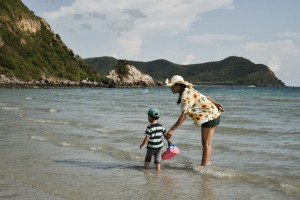 As the heat continues to rise for the summer, many of us will find ourselves seeking relief in water activities. Great memories can be created with water. You might have childhood memories of spending weekends at the lake, vacationing by the ocean or simply running through a sprinkler on those extra hot summer days. When there is water, typically fun is involved. Children especially enjoy water activities as they can splash in a pool, jump in a puddle or use the bathtub as a place to experiment with how toys may float or sink. Amid creating all these wonderful memories with children this summer, please consider how the experts recommend staying safe in and around water.
As the heat continues to rise for the summer, many of us will find ourselves seeking relief in water activities. Great memories can be created with water. You might have childhood memories of spending weekends at the lake, vacationing by the ocean or simply running through a sprinkler on those extra hot summer days. When there is water, typically fun is involved. Children especially enjoy water activities as they can splash in a pool, jump in a puddle or use the bathtub as a place to experiment with how toys may float or sink. Amid creating all these wonderful memories with children this summer, please consider how the experts recommend staying safe in and around water.
It is a devastating fact to report, but drowning is one of the leading causes of accidental death in countries all around the world (Vähätalo, Lunetta, Olkkola, & Suominen, 2014; Wallis, Watt, Franklin, Nixon, & Kimble, 2015). Children aged 1 to 4 face the highest drowning rates, making it critical to share water safety information with all parents (Centers for Disease Control and Prevention (CDC), 2016; Government of Canada, 2016). At this age, most drownings occur in swimming pools (CDC, 2016). It is important to understand that young children are particularly vulnerable to drowning because they can drown in only a few inches of water (American Academy of Pediatrics, 2015). In addition to this, drowning can happen very quickly and quietly, which leaves little time for individuals to respond in these tragic situations (Government of Canada, 2016). This topic is difficult to discuss, as is any topic that threatens the well-being of young children. As the summer season swings into gear, make wonderful memories with the children in your life, while keeping these water safety tips in mind.
Water Safety Tips from the Experts!
• When a pool is not in use, put toys away. These can capture a child’s attention and be used as a tool for climbing when an adult is not around.
• Empty blow-up pools when they are not in use.
• Be aware of small bodies of water as these attract a child’s attention. These include: bathtubs, fishponds, fountains, and even buckets used for cleaning. Most infant drownings occur in bathtubs and buckets.
• Keep a cover on pools when not in use and always completely remove the cover before swimming. Never let children walk on a pool cover.
• Always have children wear a life jacket when they are swimming or riding in a boat. Do not let children use inflatable toys or mattresses in place of a life jacket.
• Eliminate distractions while supervising children in water. Adults should avoid: talking on the phone, working from a laptop, or any other task that could distract a parent from giving children their full attention.
(American Academy of Pediatrics, 2013; American Academy of Pediatrics, 2015; Government of Canada, 2016)
As you embark on your summer adventures, keep in mind that the experts recommend infants and toddlers should have extra supervision when around water. The American Academy of Pediatrics (2017) shares that newborn infants and children through age 4 should NEVER be left alone around any water, not even for just a moment. Infants and young children should always be supervised by an adult and not another child when in or near water.
Because children this age are at such a high risk for drowning, pediatricians now teach a technique called “touch supervision” to parents. This means that anytime a child 4 or younger is in or near water, an adult should be within arm’s length of the child and have their full attention on the child at all times. By doing this, parents can be assured that their children are having fun, while being kept safe.
Though we hope to never have to use CPR, parents can also consider finding out about becoming CPR certified. Parents may speak with their child’s pediatrician if they would like more information about learning how to perform CPR during emergencies. As you enjoy your summer, keep children close to you, particularly in and around water. Take a swim, walk by the beach, ride in a boat, but remember, be safe and always stay focused on the children.
References
American Academy of Pediatrics. (2017, May 16). Drowning prevention:
information for parents. Retrieved from: https://www.healthychildren
.org/English/health-issues/injuries-emergencies/Pages/Drowning.aspx
American Academy of Pediatrics. (2013, August 6). Swimming pool safety.
Retrieved from: https://www.healthychildren.org/English/safety-
prevention/at-play/Pages/Swimming-Pool-Safety.aspx
American Academy of Pediatrics. (2015, November 21). Water safety: Tips for
parents of young children. Retrieved from: https://www.healthychildren
.org/https://www.healthychildren.org/English/safety-prevention/at-
play/Pages/Water-Safety-And-Young-Children.aspx
Center for Disease Control and Prevention. (2016, April 28). Unintentional
drowning: Get the facts. Retrieved from: https://www.cdc.gov
/homeandrecreationalsafety/water-safety/waterinjuries-factsheet.html
Government of Canada. (2016, March 3). Swimming safety. Retrieved from:
https://www.canada.ca/en/health-canada/services/injury-
prevention/swimming-safety.html
Vähätalo, R., Lunetta, P., Olkkola, K. T., & Suominen, P. K. (2014). Drowning
in children: Utstein style reporting and outcome. Acta Anaesthesiologica
Scandinavica, 58(5), 604-610. doi:10.1111/aas.12298
Wallis, B. A., Watt, K., Franklin, R. C., Nixon, J. W., & Kimble, R. M. (2015).
Drowning mortality and morbidity rates in children and adolescents 0-19
yrs: a population-based study in Queensland, Australia. Plos One, 10(2),
e0117948. doi:10.1371/journal.pone.0117948

